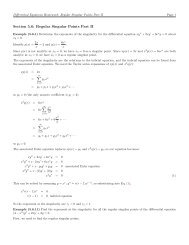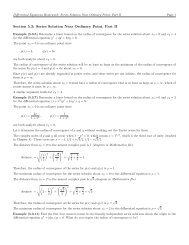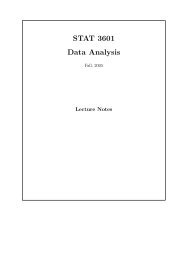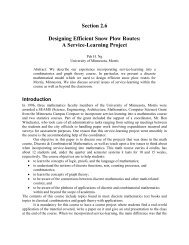Final Exam Questions
Final Exam Questions
Final Exam Questions
Create successful ePaper yourself
Turn your PDF publications into a flip-book with our unique Google optimized e-Paper software.
<strong>Final</strong> <strong>Exam</strong> <strong>Questions</strong> -- Spring ‘11<br />
Econ 4131: International Finance<br />
1. Explain the complete derivation of the AA (asset market equilibrium) and DD (goods market<br />
equilibrium) curves from Krugman & Obstfeld’s textbook. Use these curves to analyze the effects<br />
of monetary policy and fiscal policy under fixed and under flexible exchange rates. (Ignore the XX<br />
curve)<br />
2. “You may fix the money supply or you may fix the nominal exchange rate, but you can’t do both<br />
simultaneously.” Explain this carefully, with a full explanation of the role of the central bank and<br />
its balance sheet.<br />
3. Explain how the gold standard operated in the classical period (1870-1914). What were the<br />
advantages and disadvantages? Some say the gold standard sacrificed internal balance to external<br />
balance. How? What were the “rules of the game” and what would happen when they were<br />
violated? What would happen when the demand for monetary gold rose faster than the supply, and<br />
why was this a problem?<br />
4. Explain the functioning of the Bretton Woods currency arrangement. Why was it designed as it<br />
was? What strains appeared over time, and what factors led to its collapse? What was “Triffin’s<br />
dilemma”? (Look up Triffin in the index to the textbook). How is Triffin’s Dilemma relevant to<br />
our current payments imbalance with China?<br />
5. Use the interest rate parity condition (underlying the AA curve) to show what effect an expected<br />
devaluation (say 10%) will have on the domestic economy (particularly domestic output) assuming<br />
that the central bank fights to defend the initial fixed parity. What will the consequences be for<br />
internal and external equilibrium? What would be an appropriate policy response to restore internal<br />
and external equilibrium?<br />
6. Consider a country that exports oil, and basically nothing else. Assume that there is a sudden and<br />
apparently permanent collapse of world oil prices. Use a version of the AA-DD model to analyze<br />
and discuss the nature of the macroeconomic shock and adjustment under: i) a flexible exchange<br />
rate regime; ii) a fixed exchange rate regime. Discuss the best policy options in both cases.<br />
7. In the AA-DD model with flexible exchange rates, explain how expansionary fiscal policy<br />
affects the current account and employment, and why. Explain how expansionary monetary policy<br />
affects the current account and employment. Draw a grid with 2 columns (Over employment,<br />
Under-employment) and two rows (CA surplus, CA deficit). In each cell, indicate which policy<br />
should be used (monetary vs. fiscal), and which direction it should take (expansionary vs.<br />
contractionary).<br />
8. A gold-standard is basically equivalent to a fixed exchange rate regime where there is no policy<br />
option of devaluation. Discuss the shock in (6) above, and how the economy would adjust to<br />
internal and external balance if it were following a strict gold standard.<br />
9. Using the AA-DD model from chapter 17, carefully explain how a devaluation affects<br />
employment and the trade balance, starting with a shift in the interest-parity curve. Describe the<br />
transition from the original to the new equilibrium (i.e. what changes immediately, what changes<br />
gradually). Under what circumstances will this policy be superior to expansionary fiscal policy?<br />
10. What is is involved in “sterilization” of a capital flow? Why and under what circumstances<br />
might a country attempt to sterilize capital movements? What factors make sterilization more or<br />
less likely to succeed?
11. In the aftermath of the Mexican peso crisis in the mid 1990s, international investors launched<br />
speculative attacks very selectively against countries with weakened banking systems (i.e. with<br />
high non-performing loan portfolios), and not against countries with healthier banking systems.<br />
What is the logic behind this behavior?<br />
12. Reinhart & Rogoff (2009) discuss patterns of financial crises based on a long historical dataset.<br />
Discuss some of the key features they identify as characteristic of crises. How is the U.S. crisis<br />
(which began in 2007) the same as or different from the comparison group(s)? Since our crisis is<br />
still rolling on, what does the R&R analysis suggest that we have in store for us over the next<br />
couple of years?













